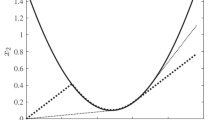Abstract
A computing algorithm, based on the geometry of certain reachable sets, is presented for fixed terminal time optimal regular problems having differential equations\(\dot x = f(x ,u , t)\). Admissible controls must be measurable and have values in a setU, which must be compact, but need not be convex. Functionsf(x, u, t) andf x (x, u, t) must be continuous and Lipschitz inx andu, but existence off u (x, u, t) or second derivatives is not required.
The algorithm is based on taking a sequence of nonlinear steps, each of which linearizes\(\dot x = f(x ,u , t)\) in state only, about a current nominal control and trajectory. Small perturbations are assured by keeping the perturbed controlclose to the nominal control. In each nonlinear step, a regulator problem,linear in state, is solved by a convexity method of Barr and Gilbert (Refs. 1–2), which is undeterred by the possibility of singular arcs. The resulting control function is substituted into the original nonlinear differential equations, producing an improved trajectory.
Convergence of the algorithm is not proved, but demonstrated by a computing example, known to be singular. In addition, procedures are described for choosing parameters in the algorithm and for testing for theplausibility of convergence.
Similar content being viewed by others
References
Barr, R. O.,An Efficient Computational Procedure for a Generalized Quadratic Programming Problem, SIAM Journal on Control, Vol. 7, pp. 415–429, 1969.
Gilbert, E. G.,An Iterative Procedure for Computing the Minimum of a Quadratic Form on a Convex Set, SIAM Journal on Control, Vol. 4, pp. 61–80, 1966.
Neustadt, L. W., andPaiewonsky, B.,On Synthesizing Optimal Controls, Proceedings of the Second Congress of the International Federation of Automatic Control (IFAC), Butterworth Publishers, London, England, 1964.
Neustadt, L. W.,Minimum Effort Control System, SIAM Journal on Control, Vol. 1, pp. 16–31, 1962.
Neustadt, L. W.,Synthesizing Time Optimal Control Systems, Journal of Mathematical Analysis and Applications, Vol. 1, pp. 484–492, 1960.
Eaton, J. H.,An Iterative Solution to Time Optimal Control, Journal of Mathematical Analysis and Applications, Vol. 5, pp. 329–344, 1962 (for Errata and Addenda, see Vol. 9, pp. 147–152, 1964).
Barr, R. O., andGilbert, E. G.,Some Efficient Algorithms for a Class of Abstract Optimization Problems Arising in Optimal Control, IEEE Transactions on Automatic Control, Vol. AC-14, pp. 640–651, 1969.
Barr, R. O.,Computation of Optimal Controls by Quadratic Programming on Convex Reachable Sets, University of Michigan, Ph.D. Dissertation, 1966.
Frank, M., andWolfe, P.,An Algorithm for Quadratic Programming, Naval Research Logistics Quarterly, Vol. 3, pp. 95–110, 1956.
Halkin, H.,On the Necessary Condition for Optimal Control of Nonlinear Systems, Journal d'Analyse Mathématique, Vol. 12, pp. 1–82, 1964.
Halkin, H.,Method of Convex Ascent, Computing Methods in Optimization Problems, Edited by A. V. Balakrishnan, and L. W. Neustadt, Academic Press, New York, New York, 1964.
Filipov, A. F.,On Certain Questions in the Theory of Optimal Control, SIAM Journal on Control, Vol. 1, pp. 76–84, 1962.
Katz, P. L.,Computation of Optimal Controls for Some Problems Nonlinear in State and Control by a Geometric Method Using Repeated Linearization, University of Michigan, Ph.D. Dissertation, 1970.
Hermes, H., andLaSalle, J. P.,Functional Analysis and Time Optimal Control, Academic Press, New York, New York, 1969.
Barr, R. O., andGilbert, E. G.,Some Iterative Procedures for Computing Optimal Controls, Proceedings of the Third Congress of the International Federation of Automatic Control (IFAC), Butterworth Publishers, London, England, 1966.
Athans, M., andFalb, P. L.,Optimal Control, McGraw-Hill Book Company, New York, New York, 1966.
Katz, P. L.,Reachable Sets and Singular Arcs for Minimum Fuel Problems Based on Norm Invariant Systems, IEEE Transactions on Automatic Control, Vol. AC-17, pp. 557–559, 1972.
Gilbert, E. G., andHarasty, G. A.,A Class of Fixed-Time Fuel-Optimal Impulsive Control Problems and an Efficient Algorithm for Their Solution, IEEE Transactions on Automatic Control, Vol. AC-16, pp. 1–11, 1971.
Katz, P. L., andWachtor, T. E.,Optimal Solutions of a Nonlinear Minimum Fuel Problem and Minimum Time Orbital Transfer Problem, Computed Without Prior Knowledge of Singular Arcs' Existence, International Journal of Control, Vol. 20, pp. 673–688, 1974.
Auerbach Computer Corporation,System Performance Comparison Charts, Auerbach Computer Notebook, Auerbach Computer Corporation and Auerbach Information, Incorporated, pp. 11:400.100-11:400.113, 1969.
Author information
Authors and Affiliations
Additional information
Communicated by T. N. Edelbaum
The author wishes to thank his dissertation advisor, Dr. E. G. Gibert, for his numerous helpful comments and suggestions. Thanks also go to Dr. J. D. Ferguson, Dr. N. T. Hamilton, Dr. W. F. Powers, and Dr. A. C. Robinson for their assistance at various stages of this work. The University of Illinois at Chicago Circle Computer Center provided extensive free computer time and excellent service, without which this work would have been impossible. The prompt and accurate typing of Miss Wandell Poe and Miss Mary Rakauskas eliminated many difficulties in preparing the final copy.
Rights and permissions
About this article
Cite this article
Katz, P.L. A geometric computing method for nonlinear optimal regulator problems with singular arcs. J Optim Theory Appl 15, 249–284 (1975). https://doi.org/10.1007/BF00933338
Issue Date:
DOI: https://doi.org/10.1007/BF00933338



